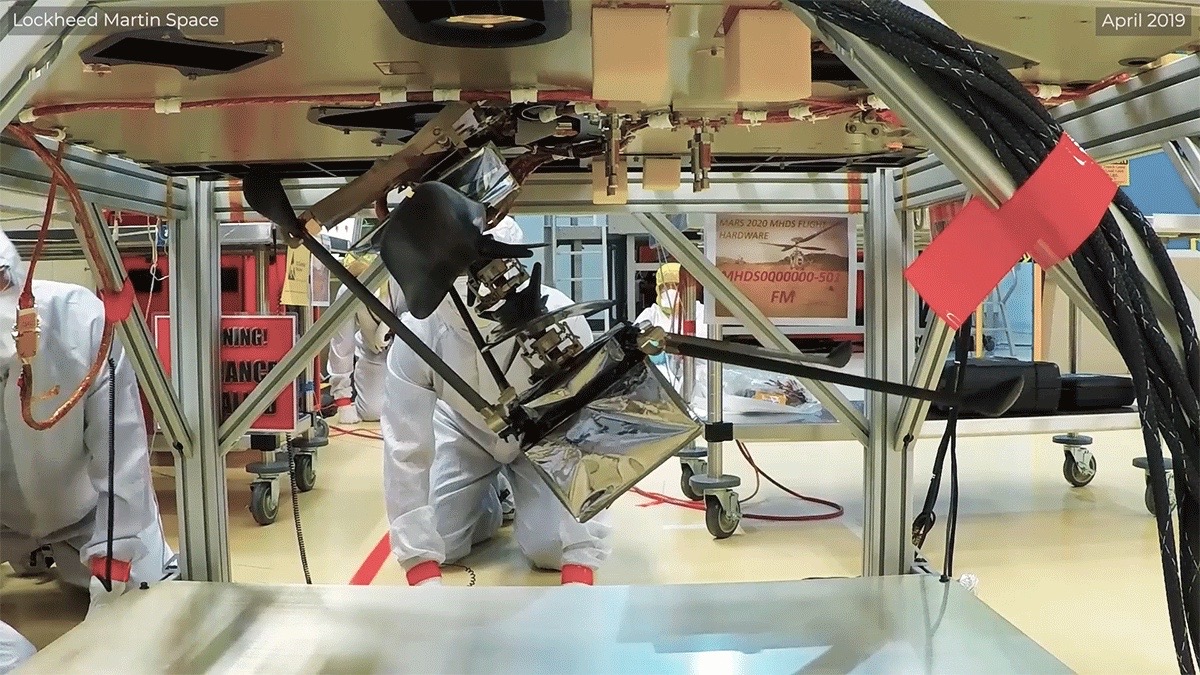The 1st-ever Mars helicopter will start flying next year. Here's how.
Ingenuity could pave the way for extensive exploration of the Martian skies.

NASA's Perseverance rover will have a special passenger when it alights inside Mars' Jezero Crater in February 2021 — the first helicopter ever to fly on another world.
The 4-lb. (1.8 kilograms) chopper, named Ingenuity, will ride to Mars on Perseverance's belly, squeezing into a spot that offers roughly 24 inches (61 centimeters) of ground clearance, including the helicopter delivery system. Ingenuity itself is only 5 inches (12 cm) shorter than the clearance area.
"That is not a lot of room to play with," Chris Salvo, the helicopter interface lead of Mars 2020, the official name of Perseverance's mission, said in a statement.
"But we found if you attach the helicopter horizontally, there is enough to get the job done," said Salvo, who's based at NASA's Jet Propulsion Laboratory (JPL) in Pasadena, California.
Related: NASA's Mars 2020 rover Perseverance in pictures
Ingenuity will continue clinging to Perseverance for about two months after the rover's landing on Feb. 18, 2021. The two machines (with help from remote operators on Earth) will hunt for a flat, unobstructed area where Ingenuity can do test operations.
The team will need to find a zone that is about 33 feet by 33 feet (10 by 10 meters) that Perseverance can monitor while parked about one American football field away, mission team members said. Ingenuity's deployment will happen after Perseverance drives into the center of the airfield. Operators will spend about six Earth days checking all systems before getting the helicopter ready to fly.
Get the Space.com Newsletter
Breaking space news, the latest updates on rocket launches, skywatching events and more!
"The deployment process begins with the release of a locking mechanism that keeps the helicopter in place," JPL officials wrote in the statement. "Then a cable-cutting pyrotechnic device fires, allowing a spring-loaded arm that holds the helicopter to begin rotating Ingenuity out of its horizontal position. Along the way, a small electric motor will pull the arm until it latches, bringing the helicopter body completely vertical with two of its spring-loaded landing legs deployed. Another pyrotechnic fires, releasing the other legs."
During this process, the deployment system will maintain electrical and data connections between Perseverance and Ingenuity until it's time to let the helicopter loose. The plan is to gently drop Ingenuity to the surface and to have Perseverance drive away, allowing Ingenuity to charge its batteries with a solar panel. Then, if all goes to plan, it will be time to do a few test flights.
Ingenuity is designed to operate for 30 sols, or Martian days, to see how feasible Red Planet flight will be for future missions. Engineers will use the lessons learned from Ingenuity, which carries no onboard instruments, to potentially build future helicopters that can assist rovers and perhaps, even astronauts.
Some possible uses for future Mars choppers include scouting ahead for tricky terrain, studying vertical cliffs and exploring caves or deep craters that a rover may not be able to reach, NASA officials said.
Perseverance's main goals involve searching for signs of ancient Mars life and caching promising samples for future return to Earth. The rover also carries technology demonstrations that could aid future human explorers on the Red Planet, including an instrument designed to make oxygen from the thin, carbon dioxide-dominated Martian atmosphere. NASA aims to put boots on Mars sometime in the 2030s, after returning astronauts to the moon in this decade.
Perseverance will launch to Mars no earlier than July 30 of this year, eventually joining NASA's long-running Curiosity rover on the Red Planet surface. Curiosity landed in August 2012 and is still going strong.
Follow Elizabeth Howell on Twitter @howellspace. Follow us on Twitter @Spacedotcom and on Facebook.
Join our Space Forums to keep talking space on the latest missions, night sky and more! And if you have a news tip, correction or comment, let us know at: community@space.com.

Elizabeth Howell (she/her), Ph.D., was a staff writer in the spaceflight channel between 2022 and 2024 specializing in Canadian space news. She was contributing writer for Space.com for 10 years from 2012 to 2024. Elizabeth's reporting includes multiple exclusives with the White House, leading world coverage about a lost-and-found space tomato on the International Space Station, witnessing five human spaceflight launches on two continents, flying parabolic, working inside a spacesuit, and participating in a simulated Mars mission. Her latest book, "Why Am I Taller?" (ECW Press, 2022) is co-written with astronaut Dave Williams.
